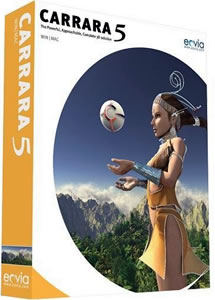Caligari Truespace 5
Caligari Truespace has been around since the beginning of time; i.e., in terms of 3D content development. In fact, Truespace was one of my first 3D programs running on an Amiga ‘ yes, a Commodore Amiga.
TrueSpace has been around for a number of years. Caligari has remained in the market by offering a nicely featured package that provides basic modeling, texturing. Caligari TrueSpace 終了. 今回は、2013 以降変わっていなかった、DWGのファイルフォーマットが5バージョンぶりに変わって2018. TrueSpace, free and safe download. TrueSpace latest version: A free Design & photography program for Windows. TrueSpace is a.
When I finally found my way into the visual effects industry, my awareness of Truespace diminished, as my head had to make room for Lightwave, 3DStudio, PowerAnimator, Softimage, and then, Maya. So, I was happy to find out that its staying power is quite impressive given the competition. In release 7.5 now, Truespace falls into the same development maturity as its more well-known brethren. In this latest release, lots of tools have been added to keep up with the Joneses; character development with rigging and advanced IK, mixing animations between dynamics, keyframe, and motion capture, high-level rendering features like hair, sub-surface scattering, HDRI implementation and integration with VRay (sold separately) and incorporation of scripting languages.
Yes, you see an ‘s’ on the end of language instead of one proprietary language, Caligari allows its userbase to develop with Jscript, Lua, Python and VBScript. Now, this is truly a way to keep up with current technology, so, you might ask ‘What is different about Caligari Truespace?’ and that’s a very legit question. It’s doubtful that Truespace will prevent Autodesk from ultimately creating the 3D equivalent of the New World Order.
However, Caligari has carved out its own niche in the industry by having its focus on 3D web content, and more specific, a method of live collaboration within a virtual environment on the web. Distributed artists can work on the same assets at the same time in the same 3D space.
This truly makes development available to a world community working remotely, and clients can participate in reviewing assets online through the free 3D truePlay application. For $595 (with an additional $299 for Vray) you can get started with an incredibly robust 3D toolset, and you’ll be one step ahead of the key players when you are showing off your latest creation to your clients inside a 3D conference room which you’ve built on your own.
Website: www.caligari.com Price: $595.
By George Maestri Caligari's TrueSpace has been around for a number of years and has always offered a solid set of tools for a reasonable price. Version 5 builds on this legacy with a number of new tools and some interface improvements. TrueSpace presents itself with a single perspective view, but you also can configure it to show orthographic views. The interface is entirely icon-based, which means all operations are represented as pictures, with a text description that shows up on the taskbar. This looks great, but initially I found some icons a bit hard to decipher, making me want basic pull-down menus.
After a day or so, though, I had most of the icons memorized, which made the interface fairly quick. TrueSpace 5's radiosity feature enables users to obtain realistic lighting conditions both in the viewport and for rendering. One of the most significant improvements to Version 5 is the completion of the NURBS modeler that initially shipped with Version 4. The software enables you to draw NURBS curves and manipulate them using the new draw panel, which gives each curve its own miniature editing window within the 3D environment. Oddly, NURBS curves in TrueSpace use Bezier-type control handles rather than the more standard NURBS weights. This seems to work fine, but it might be confusing to seasoned NURBS modelers.
After you draw your curves, you can create patches using a skinning tool, which allows for multiple outlines to create a patch. You also can create surfaces using the loft and birail tools. TrueSpace enables you to draw trim curves directly on a NURBS surface to cut a hole in a patch. One thing missing is the ability to project existing curves onto a surface, which can make the modeling process more accurate than re-creating these curves from scratch. TrueSpace also has some nice tools for attaching patches to each other.
Vue 9 Pioneer
You can create blend surfaces to join surfaces with circular outlines, such as the end of an arm to a trim curve on a torso. TrueSpace has always had polygonal modeling tools and has supported subdivision surfaces for the past few releases. Subdivision surfaces make modeling organic surfaces very easy, and TrueSpace's subdivision tools work much like those in most other packages. When a surface is subdivided, the original polygonal surface appears as a 'cage,' superimposed over the smooth subdivided surface.
You can then edit or animate the cage. Polygonal modeling in TrueSpace starts with primitives, such as spheres and cubes. TrueSpace has a terrific interface for creating these objects called the Magic Ring widget, which lets you draw new primitives interactively. After you create a primitive, you can modify it.
The polygonal modeler is basic but is easy to use and gets the job done. It enables you to manipulate points, edges, or faces for sculpting the shape of an object.
For adding detail, you can perform such operations as beveling and extruding polygons. Unlike with more advanced modelers, you cannot use these operations on edges or vertices. Animation also is available for moving objects within a 3D space.
For character animation, TrueSpace offers an IK system with skeletal deformation. The IK works a bit differently from other implementations in that it uses a software 'pin' to specify the IK chain at any given moment. As such, if you move a character's hand, for example, and the pin is at the shoulder, you will reposition only the arm. If the pin is at the hip, you also will reposition the shoulders and spine.
This is a different way of working, but it has advantages in its flexibility. TrueSpace's material editor has been completely redesigned. One unique feature that I really liked is the new IIR (incremental image rendering) technology, which enables you to move a resizable material editing window over any part of the scene and edit materials directly on scene objects. This enables you to see how a material will look in the context of your scene for final rendering, which speeds production significantly. Rendering is based on the Lightworks Pro rendering engine from Lightwork Design. TrueSpace offers a variety of lights, including physically accurate lighting, based on actual, manufactured light models for tasks such as architectural design.

Caligari Truespace Tutorials
The renderer's quality is excellent, and it offers radiosity, which models the scattering of light within a scene. Overall, TrueSpace is a great application for the price. It offers a fairly complete set of features that enable the software to do many different tasks very well. It has user-friendly implementations of all the major features that an artist would need, plus it produces good-looking renders.
TrueSpace fills that niche in the market for those who need a quality 3D package but can't justify spending many thousands of dollars. George Maestri is a writer and animator living in Los Angeles. Price: $795 Minimum System Requirements: Windows /NT; Pentium II; 64MB of RAM; 50MB of free hard-disk space Caligari Corp.
Comments are closed.
